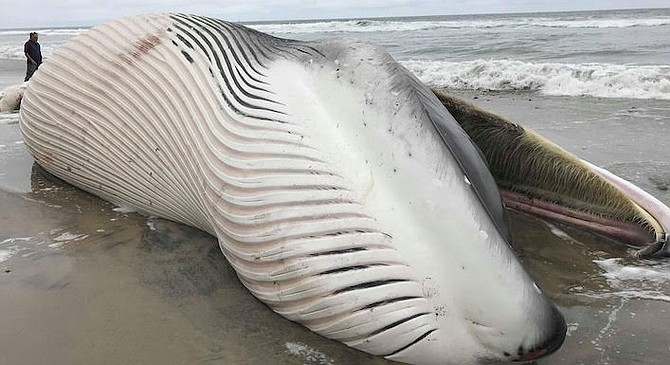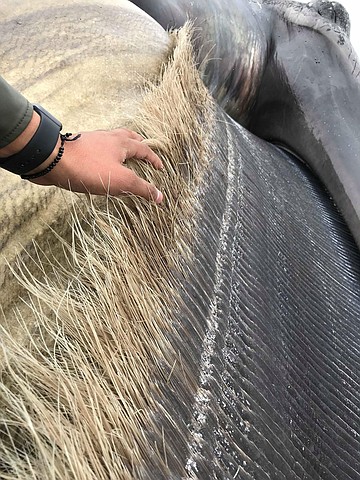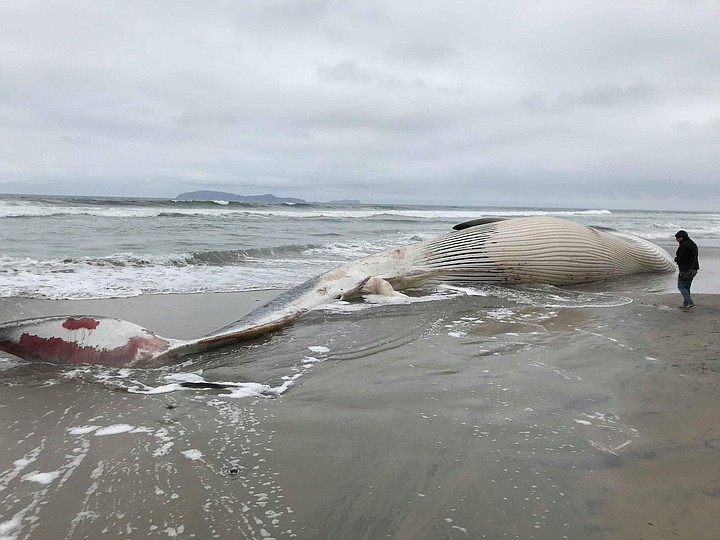 Facebook
Facebook
 X
X
 Instagram
Instagram
 TikTok
TikTok
 Youtube
Youtube

On May 20th at about noon, Adrian Urenda saw a dead whale on the beach by Las Olas Hotel in Calafia (about seven miles south of Rosarito).

“There were about ten others around the carcass,” he said, “I touched it and it felt wet and slippery.”
Urenda, a 26-year-old criminologist from Tijuana, noticed there were no police, scientists, firemen or anything related to civil protection, government or public institutions — present investigating the scene.
“It smelled a little nasty,” he said, “I think the whale was there from the day before at about 7 p.m.”

According to Mexican news outlets, the whale, which measures approximately 65-70 feet long, washed up on shore on May 19th.
“It’s a male for sure. I can see the penis in the photos,” said Federico Cota, a biologist from Ensenada.
“He’s not your usual whale. I can’t point to the exact species, but he’s not a grey whale,” Cota said, “there is no visible trauma from ship collision or from a predator such as killer whales.”

Urenda, like the others present, took photos and videos of the carcass.
“There was a hippie-like woman playing a drum next to the whale’s remains,” he said, “she was performing a ritual.”
The residents that live close by aren’t so amused by the carcass. Many are worried that the rotting scent will travel into their homes and stick on their linens and clothing.
Urenda agrees. “After that I went home and still smelled the stench on me,” he said. “I felt like vomiting.”
Cota used to work for PROFEPA (Procuraduría Federal de Protección al Ambiente), which is the agency in charge of the care and preservation of the environment throughout Mexico.
He said that his contact in PROFEPA and their team of biologists, went to the site on May 21st to do the official investigation of the carcass to determine the cause of death.
“Usually when a whale dies and beaches near human populations,” Cota said, “authorities pull it to where they can dig a big pit to bury it. Sometimes they tie a cable and drag it out to sea and because of the gases it will float, and let the current take it far to another place and while floating at sea, it usually attracts large scavengers like sharks that eventually open the guts allowing gases to be liberated and then the carcass sinks out of sight.”
According to the Mexican news outlets, the whale will be buried in a pit close by.
Nicole resides in front of the carcass. "This morning (May 22nd) at around 7 a.m., the workers have began the burying process with two bulldozers," she said.


On May 20th at about noon, Adrian Urenda saw a dead whale on the beach by Las Olas Hotel in Calafia (about seven miles south of Rosarito).

“There were about ten others around the carcass,” he said, “I touched it and it felt wet and slippery.”
Urenda, a 26-year-old criminologist from Tijuana, noticed there were no police, scientists, firemen or anything related to civil protection, government or public institutions — present investigating the scene.
“It smelled a little nasty,” he said, “I think the whale was there from the day before at about 7 p.m.”

According to Mexican news outlets, the whale, which measures approximately 65-70 feet long, washed up on shore on May 19th.
“It’s a male for sure. I can see the penis in the photos,” said Federico Cota, a biologist from Ensenada.
“He’s not your usual whale. I can’t point to the exact species, but he’s not a grey whale,” Cota said, “there is no visible trauma from ship collision or from a predator such as killer whales.”

Urenda, like the others present, took photos and videos of the carcass.
“There was a hippie-like woman playing a drum next to the whale’s remains,” he said, “she was performing a ritual.”
The residents that live close by aren’t so amused by the carcass. Many are worried that the rotting scent will travel into their homes and stick on their linens and clothing.
Urenda agrees. “After that I went home and still smelled the stench on me,” he said. “I felt like vomiting.”
Cota used to work for PROFEPA (Procuraduría Federal de Protección al Ambiente), which is the agency in charge of the care and preservation of the environment throughout Mexico.
He said that his contact in PROFEPA and their team of biologists, went to the site on May 21st to do the official investigation of the carcass to determine the cause of death.
“Usually when a whale dies and beaches near human populations,” Cota said, “authorities pull it to where they can dig a big pit to bury it. Sometimes they tie a cable and drag it out to sea and because of the gases it will float, and let the current take it far to another place and while floating at sea, it usually attracts large scavengers like sharks that eventually open the guts allowing gases to be liberated and then the carcass sinks out of sight.”
According to the Mexican news outlets, the whale will be buried in a pit close by.
Nicole resides in front of the carcass. "This morning (May 22nd) at around 7 a.m., the workers have began the burying process with two bulldozers," she said.
Comments